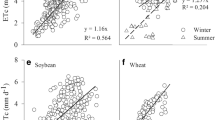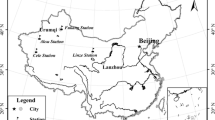Abstract
Water available for agricultural use is declining worldwide as a result of both declining water resources and increasing application costs. Managing crop irrigation under conditions where the water need cannot be fully met represents the future of irrigation in many areas. On the southern high plains of Texas there is interest among producers to reduce the amount of water applied to cotton. In this study, a producer’s efforts to reduce water application to a cotton crop were assessed in terms of a comparison between evapotranspiration, rainfall, and irrigation that is widely used in the region. The producer was able to reduce water application to meet intended reductions relative to the evapotranspiration estimates but, depending on the method used for calculating the crop water need, he tended to over water the crop in two out of three intended deficit irrigation regimes. Analysis of continuously monitored canopy temperatures provided verification of over-irrigation. Continuously monitored canopy temperature is proposed as a useful adjunct to evapotranspiration approaches to deficit irrigation management.








Similar content being viewed by others
References
Baumhardt RL, Staggenborg SA, Gowda PH, Colaizzi PD, Howell TA (2009) Modeling irrigation management strategies to maximize cotton lint yield and water use efficiency. Agron J 101(3):460–468
Burke JJ, Mahan JR, Hatfield JL (1988) Crop specific thermal kinetic windows in relation to wheat and cotton biomass production. Agron J 80(4):553–556
Faurèsa JM, Hoogeveen J, Bruinsma J (2003) The FAO irrigated area forecast for 2030. fao.org
Hake KD, Grimes DW (2010) Crop water management to optimize growth and yield. In: Stewart McD, Oosterhuis D, Heithol JJ, Mauney J (eds) Physiology of cotton. Springer, New York, pp 259–264
Hearn AB (1995) The principles of cotton water relations and there application in management. In: Constable GA, Forrrester NW (eds) Challenging the future: proceedings of the world cotton res. Conference-1, Brisbane, Australia, 14–17 February 1994
Howell T (2001) Enhancing water use efficiency in irrigated agriculture. Agron J 93(2):281–289
Jones HG (2004) Irrigation scheduling: advantages and pitfalls of plant-based methods. J Exp Bot 55(407):242–243
Lascano RJ, Baumhardt RL, Lipe WN (1992) Measurement of water flow in young grapevines using the stem heat balance method. Am J Enol Vitic 43(2):159–165
Mahan JR, Yeater KM (2008) Agricultural applications of a low-cost infrared thermometer. Comput Electron Agric 64(2):262–267
Mahan JR, Burke JJ, Wanjura DF, Upchurch DR (2005) Determination of temperature and time thresholds for BIOTIC irrigation of peanut on the Southern High Plains of Texas. Irrig Sci 23(4):145–152
Mahan JR, Conaty W, Neilsen J, Payton P, Cox SB (2010) Field performance in agricultural settings of a wireless temperature monitoring system based on a low-cost infrared sensor. Comput Electron Agric 71(2):176–181
Pate DK, Johnson JW (2010) Economic evaluation of limited irrigation production strategies on the southern high plains of Texas. In: Proceedings of 2010 Beltwide Cotton Conferences, New Orleans, Louisiana, January 4–7, 2010
Peters RT, Evett SR (2004) Modeling diurnal canopy temperature dynamics using one-time-of-day measurements and a reference temperature curve. Agron J 96:1553–1561
Pinter PJ, Hatfield SR, Schepers JS, Barnes EM, Moran MS, Daughtry CST, Upchurch DR (2003) Remote sensing for crop management. Photogramm Eng Remote Sens 69(6):647–664
Rhoades JD (1997) Sustainability of irrigation: an overview of salinity problems and control strategies. In: Footprints of humanity: reflections on fifty years of water resource developments. Proceedings of Canadian Water Resources Association (CWRA) Conference 50th. Lethbridge, Alberta, Canada pp 1–42
Stöckle CO, Dugas WA (1992) Evaluating canopy-temperature based indices for irrigation scheduling. Irrig Sci 13:31–37
Tennakoon S, Milroy S (2003) Crop water use and water use efficiency on irrigated cotton farms in Australia. Agric Water Manage 61(3):179–194
Trambouze W, Voltz M (2001) Measurement and modelling of the transpiration of a Mediterranean vineyard. Agric For Meteorol 107(2):153–166
Trout TJ, Kincaid DC (2007) On-farm system design and operation and land management. In: Lascano RJ, Sojka RE (eds) Irrigation of agricultural crops, 2nd edn. American Society of Agronomy, Madison
Upchurch DR, Wanjura DF, Burke JJ, Mahan JR (1996) Biologically-identified optimal temperature interactive console (BIOTIC) for managing irrigation. US Patent 5,539,637
Wanjura DF, Mahan JR (1994) Thermal environment of cotton irrigated using canopy temperature. Irrig Sci 14:199–205
Wanjura DF, Upchurch DR, Mahan JR (1995) Control of irrigation scheduling using temperature-time thresholds. Trans ASAE 38:403–409
Author information
Authors and Affiliations
Corresponding author
Additional information
Communicated by E. Fereres.
Rights and permissions
About this article
Cite this article
Mahan, J.R., Young, A.W. & Payton, P. Deficit irrigation in a production setting: canopy temperature as an adjunct to ET estimates. Irrig Sci 30, 127–137 (2012). https://doi.org/10.1007/s00271-011-0269-1
Received:
Accepted:
Published:
Issue Date:
DOI: https://doi.org/10.1007/s00271-011-0269-1




